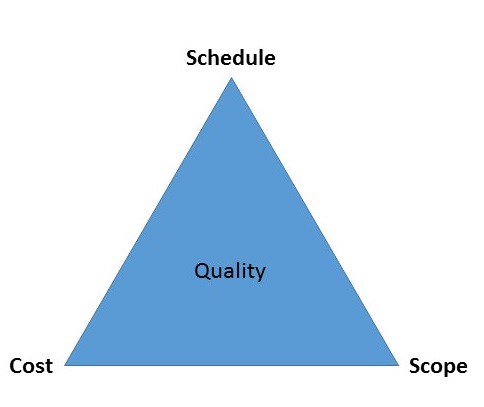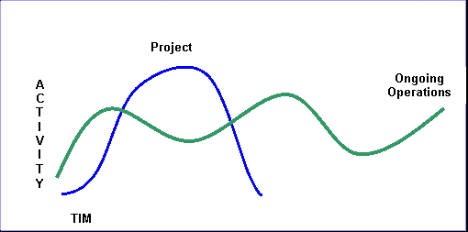پروژه چیست؟
یک پروژه یک تلاش منحصر به فرد و موقتی است که برای دستیابی به اهداف برنامهریزی شده انجام میشود و میتواند به صورت خروجیها تعریف شود (دامنه)، نتایج یا مزایا (کیفیت). یک پروژه معمولاً موفق تلقی میشود اگر اهداف را طبق معیارهای پذیرش خود، در یک زمانبندی توافق شده زمانبندی (برنامه) و بودجه هزینه).

مدیریت در مقابل مدیریت پروژه
یک عامل کلیدی که تمایز قائل میشودمدیریت پروژهاز فقط ‘مدیریت’ این است که یک خروجی نهایی و یک زمان محدود دارد، بر خلاف مدیریت که یک فرآیند مداوم است. به همین دلیل یک حرفهای پروژه به مجموعه وسیعی از مهارتها نیاز دارد؛ معمولاً مهارتهای فنی و قطعاً مهارتهای مدیریت افراد و آگاهی خوب از کسب و کار.
پروژه در مقابل عملیات روزمره
یکپروژهاین است:
“یک تلاش موقتی که برای ایجاد یک محصول، خدمت یا نتیجه منحصر به فرد انجام میشود.”
- روز به روزعملیات، از طرف دیگر، کارهایی است که در سازمانها برای حفظ کسب و کار انجام میشود.
- پروژههااز عملیات متفاوت هستند زیرا زمانی که اهدافشان به دست آمده یا پروژه متوقف شده است، به پایان میرسند.

راهنمای PMBOK موسسه مدیریت پروژه تفاوتهای زیر را بین مدیریت پروژه و مدیریت عملیات ارائه میدهد:
- موقتی بودن در مقابل دائمی بودن
- آغاز و پایان مشخص در مقابل چرخه تکراری
- محدودیتهای دامنه، زمان و بودجه در مقابل محدودیتهای زنجیره تأمین

ویژگیهای پروژه
پروژهها در اشکال و اندازههای مختلف وجود دارند. یک پروژه مجموعهای برنامهریزی شده از وظایف مرتبط است که باید در یک دوره مشخص و در چارچوب هزینه و محدودیتهای دیگر اجرا شود. ویژگیهای زیر به تعریف بیشتر یک پروژه کمک میکند:
- یک پروژه هدف منحصر به فردی دارد. هر پروژه باید یک هدف مشخص داشته باشد. به عنوان مثال، بسیاری از مردم شرکتهایی را برای طراحی و ساخت یک خانه جدید استخدام میکنند، اما هر خانه، مانند هر فرد، منحصر به فرد است.
- یک پروژه موقتی است. یک پروژه دارای آغاز و پایان مشخصی است. برای یک پروژه ساخت خانه، مالکان معمولاً تاریخی در ذهن دارند که میخواهند به خانه جدید خود منتقل شوند.
- یک پروژه تغییر را به وجود میآورد و امکان ایجاد ارزش را فراهم میکند. یک پروژه برای ایجاد تغییر به منظور برآورده کردن یک نیاز یا خواسته آغاز میشود. هدف آن دستیابی به یک هدف خاص است که زمینه (وضعیت زندگی، در این مثال پروژه خانه) را از یک وضعیت فعلی به یک وضعیت آینده مطلوبتر یا با ارزشتر تغییر میدهد.
- یک پروژه با استفاده از توسعه تدریجی یا به صورت تکراری توسعه مییابد. پروژهها معمولاً در آغاز به طور کلی تعریف میشوند و با گذشت زمان، جزئیات خاص پروژه واضحتر میشود. به عنوان مثال، تصمیمات زیادی باید در برنامهریزی و ساخت یک خانه جدید گرفته شود. بهترین کار این است که طرحهای اولیهای برای تأیید مالکان تهیه شود قبل از اینکه طرحهای دقیقتری توسعه یابد.
- یک پروژه به منابعی نیاز دارد که معمولاً از حوزههای مختلف تأمین میشود. منابع شامل افراد، سختافزار، نرمافزار یا داراییهای دیگر است. برای ساخت یک خانه به انواع مختلفی از افراد، مهارتها و منابع نیاز است.
- یک پروژه باید یک مشتری یا حامی اصلی داشته باشد. بیشتر پروژهها دارای بسیاری از طرفهای ذینفع یا ذینفعان هستند، اما کسی باید نقش اصلی حمایت را بر عهده بگیرد. حامی پروژه معمولاً جهتگیری و تأمین مالی پروژه را فراهم میکند.
- یک پروژه شامل عدم قطعیت است. زیرا هر پروژه منحصر به فرد است، گاهی اوقات دشوار است که اهداف پروژه را به وضوح تعریف کنیم، به طور دقیق تخمین بزنیم که چقدر طول میکشد تا تکمیل شود، یا تعیین کنیم که چقدر هزینه خواهد داشت. عوامل خارجی نیز باعث عدم قطعیت میشوند، مانند اینکه یک تأمینکننده از کسب و کار خارج شود یا یکی از اعضای تیم پروژه به زمان غیرمنتظرهای نیاز داشته باشد. عدم قطعیت یکی از دلایل اصلی چالشبرانگیز بودن مدیریت پروژه است، زیرا عدم قطعیت خطر را به همراه دارد.
— — — — — — — — — — — — — — — — — — — — — — — — — —
فرآیند مدیریت پروژه خود را خودکار کنید
توماس کارلایل، تاریخنگار و نویسنده مشهور، بیان کرد،
“انسان یک حیوان ابزار استفادهکننده است. بدون ابزار هیچ است، با ابزار همه چیز است.”
با پیچیدهتر شدن جهان، اهمیت توسعه و استفاده از ابزارها برای مردم، به ویژه برای مدیریت پروژههای مهم، بیشتر میشود. ابزارها و تکنیکهای خودکار مدیریت پروژه به مدیران پروژه و تیمهایشان در انجام کارها سریعتر، بهتر و آسانتر کمک میکنند.
This post is also available in Deutsch, English, Español, Français, Bahasa Indonesia, 日本語, Polski, Portuguese, Ру́сский, Việt Nam, 简体中文 and 繁體中文.













